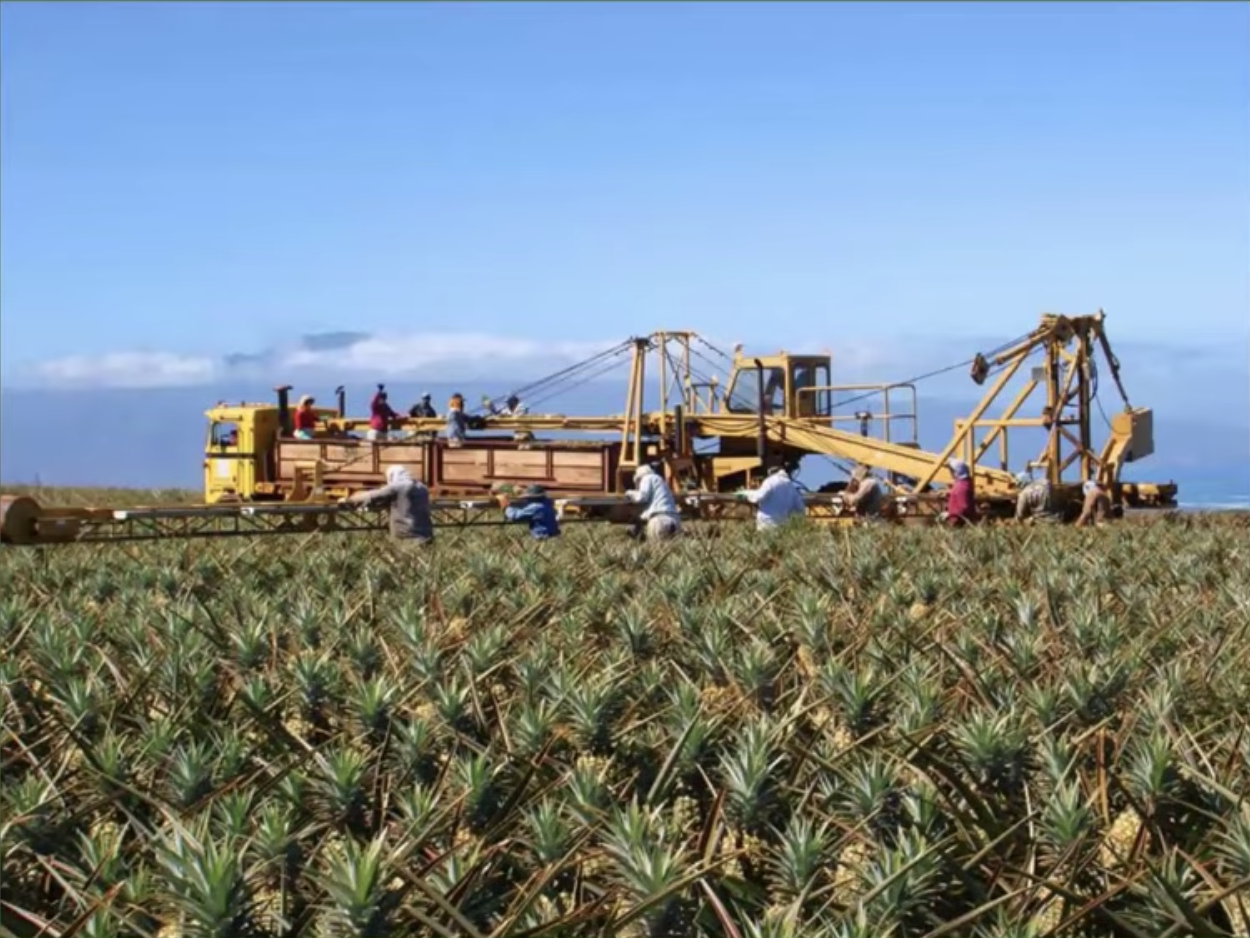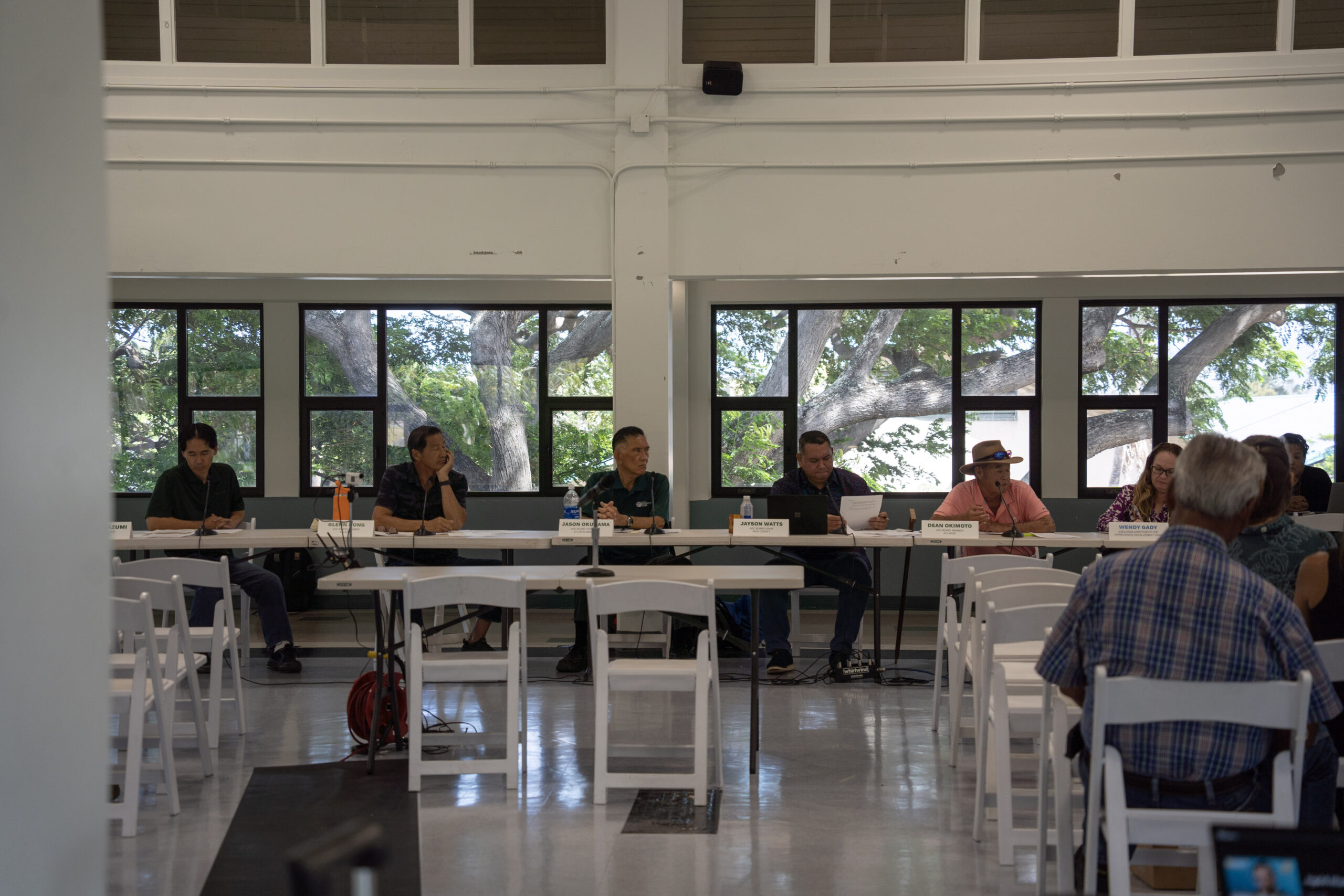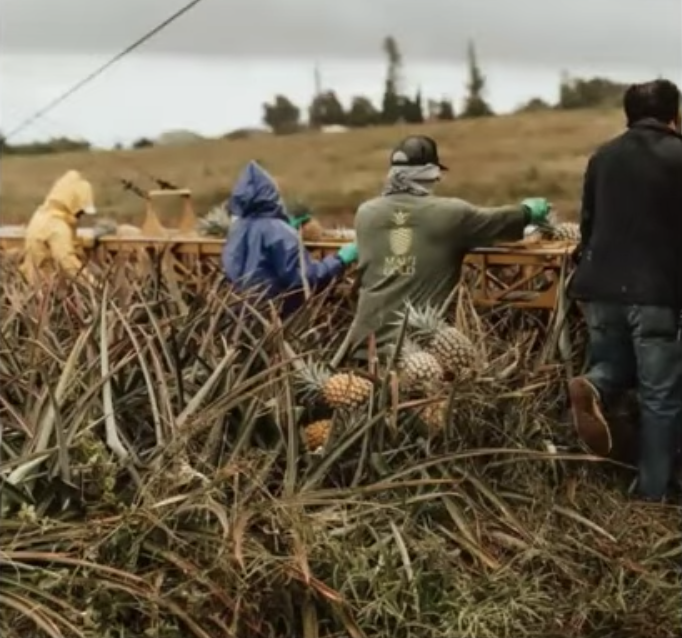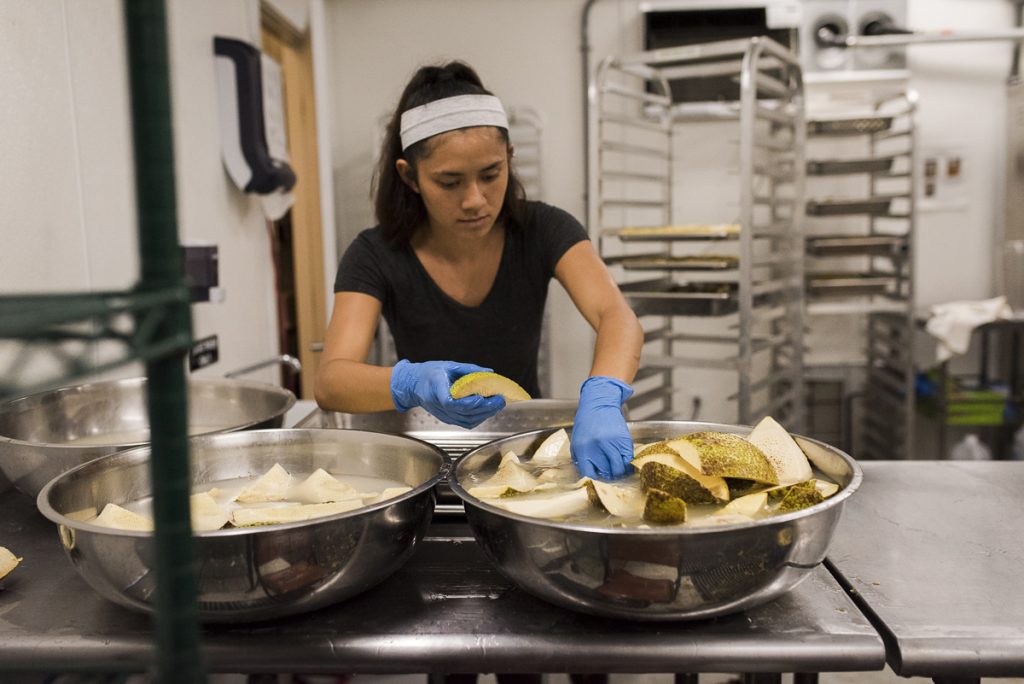 Maui Gold workers harvest pineapples from a healthy field. Photo courtesy: Hawai‘i Farm Project / Maui Gold
Maui Gold workers harvest pineapples from a healthy field. Photo courtesy: Hawai‘i Farm Project / Maui Gold
In an unfenced field overlooking a gulch, where plump yellow Maui Gold pineapples grow, axis deer climb up the hillside in the mornings and evenings “and feast away.”
Hungry wild deer and pigs have been wreaking havoc on about 20 acres of the Hāli‘imaile pineapple farm. At a cost of $165,000 per acre — for planting, maintaining machinery and the value of the harvest — the losses total about $3.3 million.
HJI Weekly Newsletter
Get more stories like these delivered straight to your inbox. Sign up for the Hawai‘i Journalism Initiative’s weekly newsletter:
ADDING YOU TO THE LIST…
That’s “pretty significant for a struggling farm,” said Max Tornai, director of grants and government affairs for the Hawai‘i Farm Project, the parent company of Maui Gold Pineapple Co.
Maui Gold leases 757 acres from Maui Land and Pineapple Co. and wants to scale up to full production, but the company is struggling with the challenges of feral animals, as well as drought.
And, Maui Gold is not alone in battling these obstacles.
“This is a big one for lots of farmers on Maui,” Tornai told the Hawai‘i Agribusiness Development Corporation on Thursday. “We are definitely getting literally eaten alive by axis deer and feral pigs. … It’s pretty devastating, especially considering the investment that went into those fields and the fact that our crops are hand-planted.”
Tornai and other farming officials came to the Agribusiness Development Corporation’s board meeting last week — the first held on Maui in the state agency’s 31-year existence — to share their struggles and the ways they hope the board can help local farmers succeed. They want funding and support to fend off deer and pigs, more investments in irrigation and on-island facilities such as cold storage, and programs to help farmers get their products to market.
The Hawai‘i State Legislature created the agency in 1994 “to replace and repurpose lands, irrigation systems and other agricultural assets left idle after the closure of sugar and pineapple operations.” It’s currently working on a statewide strategic plan and setting one-year, five-year and 10-year priorities.
 The Agribusiness Development Corporation, which is chaired by Maui resident Jayson Watts (fourth from left) holds its first meeting on Maui Thursday at the University of Hawai‘i Maui College campus. HJI / COLLEEN UECHI photo
The Agribusiness Development Corporation, which is chaired by Maui resident Jayson Watts (fourth from left) holds its first meeting on Maui Thursday at the University of Hawai‘i Maui College campus. HJI / COLLEEN UECHI photo
Warren Watanabe, executive director of the Maui County Farm Bureau, told the board that “Maui’s agriculture is in an extreme state of flux.” It’s been 16 years since Maui Land & Pineapple Co. shut down its century-old plantation, and nine years since Hawaiian Commercial & Sugar Co. on Maui shuttered the last sugar plantation in the state.
The decline of widescale sugar and pineapple production offered a break for the soils that struggled under decades of monocropping and allowed for the return of water to East Maui streams. But their steady disappearance also impacted the smaller family farmers who benefitted from the “economies of scale” that came with having large quantities of crops grown on island and investments in agriculture such as cooling facilities, Watanabe said.
“When they closed, local vendors also closed, leaving our farmers with limited access to products and increased costs,” Watanabe said. “It appears increased self-sufficiency or increased farm-to-school production is best achieved, coupled with a strong export component.”
 Workers pick pineapples in Maui Gold’s Hāli‘imaile fields. Photo courtesy: Hawai‘i Farm Project / Maui Gold
Workers pick pineapples in Maui Gold’s Hāli‘imaile fields. Photo courtesy: Hawai‘i Farm Project / Maui Gold
Maui Gold’s challenges are a reflection of what’s happening on a wider scale.
In late 2022, the Hawai‘i Farm Project acquired Maui Gold when the farm’s then-owners, LeVecke Corporation, decided to step away from pineapple cultivation on Maui, Tornai said.
The Hawai‘i Farm Project is the parent company of several different agrotourism-based operations on Maui. It started out in 2011 as the Maui Pineapple Tour, a three-person operation doing tours at the Maui Gold pineapple farm for about 2,000 guests. Over the next decade, the company grew to include the Maui Pineapple Store on Front Street, Lahaina Honey Co., Maui Farm Events, Maui Chocolate Tour at Ku‘ia Estate Chocolate in Lahaina and Maui Coconut Tour at Punakea Palms in Launiupoko.
By the end of 2022, the Hawai‘i Farm Project had grown into an operation serving more than 83,500 guests across three farms with total revenues of over $8.3 million.
Since acquiring Maui Gold, the Hawai‘i Farm Project has invested $4.3 million into the farm to date, Tornai said. The funds primarily came from the tourists who are the main customers of the pineapple tours.
The pineapple farm produces an average of 50 tons of fresh fruit per week, and 90% of the products remain in the state, going to stores and restaurants and contributing to Maui-based creations like HI Spice hot sauces and Jeff’s Jams and Jellies. More than 100 tons of fruit are sold every year to provide juice to local businesses such as Maui Brewing Co. and Maui Wine.
On Aug. 8, 2023, the Lahaina wildfire destroyed the company’s store on Front Street as well as the pineapple tour’s head office in The Wharf Cinema Center. The company also shut down its chocolate and coconut farm tours as well as Lahaina Honey Co.
The company’s store and offices reopened in Hāli‘imaile in 2024. The chocolate tour also resumed in 2024, but the coconut tour has yet to return.
High winds during the Upcountry fire, also on Aug. 8, 2023, ripped the liner on the pineapple farm’s reservoir, impacting its capacity. The liner wasn’t repaired until early 2025, “so that was a pretty significant delay in water delivery,” Tornai said.
Now, the fields are still “extremely affected by the impacts of drought and the ability to get water to our crops,” Tornai said. About 70% of Hawai‘i and 93% of Maui County is currently in drought, according to the U.S. Drought Monitor. In Maui County, nearly 60% of the area is under moderate drought, while just over 33% is in severe drought.
“Pineapple is a pretty resilient crop, but there’s a tipping point for anything that’s living in terms of water, and we have hit that with a lot of our fields,” Tornai said.
The company also is trying to protect the surviving crops from wild animals. In 2023, the state provided $90,000 to fence off some of the pineapple farm’s fields.
“You can see a direct impact for the fields that don’t have fencing,” Tornai said.
Across the gulch from a field that’s been decimated by deer, a fenced-off field of pineapple is green and thriving.
Maui Gold has also worked with the U.S. Department of Agriculture on a hunting program to control the population, which has run rampant across the island.
Tornai said that the Agribusiness Development Corporation could help farms like theirs by securing infrastructure for more consistent water delivery or funding to help with deer and other feral ungulates.
If the deer and pigs can be kept at bay, Tornai said there are lots of opportunities to grow Maui Gold and other farms.
Maui Gold recently renovated an old cutting and processing facility left behind by the previous owners and started turning smaller or “cosmetically imperfect fruit that our distributors or retailers don’t want” into cut pineapple, frozen pineapple chunks, pineapple juice and dehydrated pineapple. The facility could fill a need on Maui where “there is a bit of a desert for agricultural processing facilities and cold storage,” Tornai said.
“We wanted, as we were renovating our cutting room, our processing facility, to be forward thinking and consider the needs of other agricultural growers on Maui,” he explained. “And so we’re installing equipment that we might not be able to use, like an industrial steamer, but other producers of ‘ulu and kalo, they might want to partner with us and utilize our space in order to process their crops locally on Maui.”
On Monday, the Hawai‘i Farm Project and the Hawai‘i ‘Ulu Cooperative announced a partnership to process ‘ulu from Maui farms and package it for distribution to local restaurants, schools and hospitals. The cooperative will collect and process more than 3,000 pounds of ‘ulu weekly to start, eventually scaling up to 30,000 pounds within 10 weeks of operation.
It’s a huge boost for an organization that shipped more than 30,000 pounds of ‘ulu to Hawai‘i island last year for processing and lost over 10% due to spoilage during shipping, Tornai said.
 Breadfruit is processed at the Hawai‘i ‘Ulu Cooperative. PC: Hawai‘i Farm Project / Hawai‘i ‘Ulu Cooperative
Breadfruit is processed at the Hawai‘i ‘Ulu Cooperative. PC: Hawai‘i Farm Project / Hawai‘i ‘Ulu Cooperative
Hawai‘i is too small for farmers to compete against each other, Watanabe said. Local growers can’t easily ship their goods to other parts of the country, and they need the investments in facilities that everyone can benefit from.
Watanabe said some of the biggest challenges for farmers are land, infrastructure and labor.
“Multigenerational farms are closing,” he said. “These are farms that have the land, infrastructure and markets, and yet they close. Why? Addressing the why is important to ensure that future investments are done for the long term.”
He pointed out that multiple agencies, including the Agribusiness Development Corporation, are putting together strategic plans, but said there needs to be a “united vision of ag in Hawai‘i” that factors in all of the counties. Actions on O‘ahu impact the Neighbor Islands, and changes such as increases in shipping rates have forced the closure of some Maui farms, he said.
Darren Strand, president of the Hawai‘i Farm Bureau, said direct funding to small farms and ranches “that are often viable but struggling” is one of the best ways to help.
Strand also advocated for strategic land acquisitions and improvements to infrastructure, such as irrigation and cold storage. A lack of facilities can really hurt local production, he said, pointing out that the current closure of Maui’s only slaughterhouse is forcing some ranchers to cull their herds.
Other solutions include education and training programs, research and development, and food innovation centers like the one at the University of Hawai‘i Maui College that aims to grow agribusiness and food entrepreneurs.
He urged the board members to interact with farmers in their own communities, saying: “I think you’ll find out immediately … what makes sense for our farmers and ranchers in Hawai‘i.”